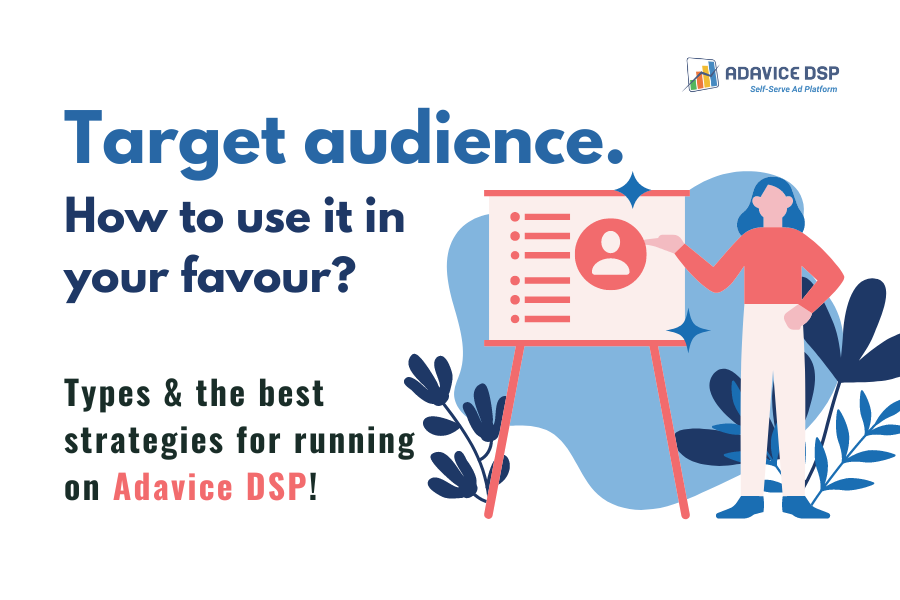

Expand your target audience knowledge with this guide: how to identity your TA, their types and audience-based strategies
You probably have heard about target audiences before. Everyone keeps mentioning how knowing your target audience helps in campaign creation and successful running. What exactly do professionals mean when talking about it?
Sure, it goes beyond “knowing your potential customer”. In the common definition target audience is identified by the group of people that are likely to become customers of a certain business. In our case, in affiliate marketing, we talk about potential leads (aka users who interact with the landing, product or service that is being promoted).
Generally in marketing field target audience combines various customer properties such
as:
- age;
- ethnicity/location;
- gender;
- education;
- occupation;
- level of income, etc.
In affiliate marketing, in addition to the above-mentioned criteria, advertisers look at many other factors. Take a look at the picture below:

It is essential to form the full target audience image before starting the campaign. After the main factors (age, geo, income, etc) consider their interests related to the topic of your promotion, websites that may be visited by them, ad type and approach they would prefer.
Why is knowing the target audience important?
It is more or less obvious that it makes the campaign process easier but let’s look into it in detail.
1) Target audience helps in focusing campaign’s resources on the right users: it may be beneficial to test all user categories but knowing the certain lead patterns can help in running the campaign;
2) Reduced cost: targeting the certain settings helps avoid the first all-in tests and thus creating a more costly-effective running period;
3) Matching strategies and optimization: using the target audience knowledge helps in creating more specialized promotion and optimization strategies;
4) More attention to the content & creatives: spending less time on the initial texts opens a door to the funnel and creatives optimization. Use this freedom to experiment with creatives and user engagement with the landing, prelander and ads!

Knowing your target audience also works the other way around. If an affiliate sticks to one particular offer type (thus focuses on the same target audience) they can plan what advertisers to partner with and what marketing channels to use for promotion.
It is not that hard to identify your target audience. In the affiliate marketing world it may change according to the offer type you choose. For example, Forex users would have different interests from, let’s say, dating website users. And that needs to be considered for the future campaign!
How to define your target audience?

Consider these easy steps that help affiliates in analyzing their target audience.
- Analyze your offer’s niche: check out the trends, what your potential users may be
interested in: for example, users interested in online dating will be interested in dating
websites and apps, while people interested in betting will look specifically for upcoming
sport/igaming events and profit opportunities;
- Determine competitors: despite the target audience analysis, competitor research is
helpful
in checking the offers in your desired category and comparing your tools, creatives,
solutions with other affiliates. Various Spy tools are available online for a competitor
research;
- Determine the user’s portrait: age, gender, geo, socioeconomic factors, interests -
use
everything that may help is setting more detailed targeting;
- List potential user’s pain points: after getting the user’s portrait think about the
problems users are facing. Some examples may include: uncertainty in committing, bad
previous experience in a similar niche for the user, etc;
PRO TIP: The main points method can work in the opposite direction as well: the problems can be identified at first and then the user’s portrait.
- Examine the existing audience: this method doesn’t work for the beginner affiliates, however, if you have promoted before try looking into the existing history, check the user patterns and converting funnels.
When launching on Adavice DSP don’t forget the tracking importance! Use of tracking and various tracking parameters helps in the in-depth analysis of potential users and leads. Check additional info on tracking in our Blog:
Take a look at some of Forex’s disadvantages:
- Tracking with Adavice
DSP
- Tracking parameters
Target audience type should be considered when choosing the type of offer, goals and the strategy of the campaign. Depending on these factors several target audiences may be selected for testing. Then it is better to consider different promotion strategies for target audience types.
Let’s consider some target audience types that you as an affiliate may form before starting the first testing or using your own databases.
Here is a list of the most common target audience groups by types:
- Country (target audience is formed based on geo factor)
- Income level (for the relevant information check income levels per country tiers or
official
country’s statistics)
- Demographic factors (such as gender, age, etc)
- Ad type (leads or impressions from a certain ad category)
- Users’ interests and many more
The list of potential target audiences is endless. Remember that the target audience interconnects with the campaign’s type, goal and promotion means.
Now the target audience is defined and analyzed. Before creating the campaign we recommend setting a strategy and the goals for it so it would be easier to follow the plan and check the results on the way.
In this section we will briefly discuss the most popular target audience strategies as well as their pros and cons. It is important to know when starting the first tests or modifying your own running strategy.
PRO TIP: There are many other strategies, all depend on each offer case. Don’t hesitate to try multiple variants to choose the most effective and profitable for your offer!
1) Broad strategy
The broad strategy is perfect for the first-time launching when the affiliate does not know the particular target audience of the offer. Such a strategy often focuses on increasing the number of impressions. The more potential users see the ad, the higher the probability of targeted action is. After testing a broad strategy and defining the converting settings, one can switch straight to the optimization plan or continue testing another target audience strategy.
As good as it may sound broad strategy has its own pros and cons:
Pros:
- easier to create comparing to specific targeting campaign
- focuses on great number of users
- less costly than others
Cons:
- some GEOs or sources may not show good results
- does not take market changes into consideration
- there is no focus on a certain target audience
2) Geo targeting
Location or so-called geo strategy includes targeting of a specific geo, area or language. Sometimes, as in dating or gambling campaigns, it is needed to include or exclude specific geo targeting. Advertisers may also put additional restrictions on the settings based on the offer’s requirements.
Pros:
- Focusing on a certain target audience
- Possible to target higher income areas/geos
- High ROI
- Relevance due to geo targeted offer and creatives
Cons:
- Harder on optimization
- Time-consuming creation
- Results may change while running due to GEOs competitions
3) Specific targeting
Specific or concentrated targeting strategy deals directly with the target audience. After identifying the potential users or customers of the offer the affiliate builds the whole promotion strategy around this data. Unlike 2 previous strategies, the drawback of this type is that it needs a valuable amount of data for analysis before launching.
Pros:
- Focus specifically on target audience
- Several sub strategies may be chosen
- More creative approach comparing with previous ones (funnels, ads & messages)
- Cost-effective (starting from working settings)
Cons:
- Limits the broader reach of users
4) Retargeting
Retargeting strategy allows affiliates to retarget already collected user groups. These may be users that failed to complete the funnel at some point or the leads who performed the targeted action.
Adavice Team is working on this feature at the moment to be added to the DSP targeting options, so stay tuned ;)
In the meantime, this feature is already available on our Managed service. Get the additional information at sales@adavice.com!
5) Content-based strategy (creatives)
Ready to test a bunch of creatives? Content-based strategy concentrates on the visual part
of the campaign and its optimization. Push campaigns are a perfect start for such a strategy
as it allows users to create multiple ads in the same campaign and modify them on the go.
Check the full guide on push campaigns here!
Later in the run it is possible to add several other targets and create parallel campaigns
in order to test different creative approaches.
PRO TIP: Creative approaches can be applied for different funnel stages. Try testing several creative sets & strategies targeting different funnel stages.
Pros:
- Client-targeted creatives
- Relative content
- Can be combined with sources targeting (whitelists)
- Creative approach (focus on ads and funnels testing)
Cons:
- Time-consuming creation
- Needs a lot of creatives to test in sets
- More costly in comparison with the previous ones
Check our tips on creative optimization from our amazing Team in the Blog!

Read more extensive guides in our Blog’s Insights ;)
We hope this article was helpful to all the affiliate friends launching on Adavice DSP! As always, we are waiting for your feedback and questions at sales@adavice.com 🙂
Rate this article